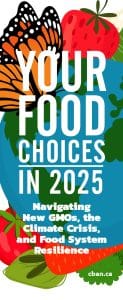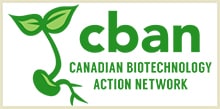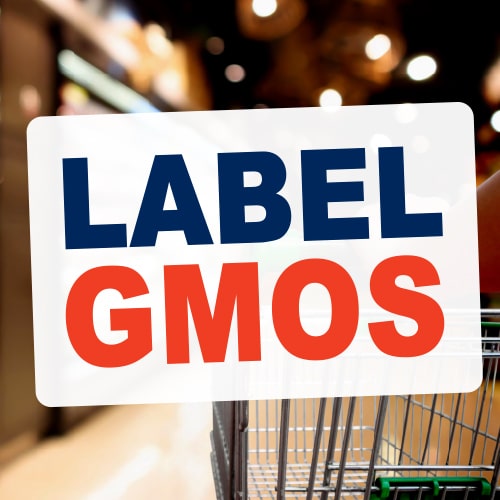Your Food Choices in 2025
The pamphlet “Your Food Choices in 2025” provides an introduction to the problem of climate crisis, corporate control and toxic chemicals – and the solution of organic, local and independent food. It also briefly explains the new genetic engineering techniques of gene editing, which are being used to create new GMOs, and provides a list of genetically engineered (genetically modified or GM) foods in Canada. It provides information and options for consumers who are seeking food choices that align with their values and vision. What can we do? The pamphlet lists some important food choices that can support a healthy environment and support farmers who are growing food for a better future.
provides an introduction to the problem of climate crisis, corporate control and toxic chemicals – and the solution of organic, local and independent food. It also briefly explains the new genetic engineering techniques of gene editing, which are being used to create new GMOs, and provides a list of genetically engineered (genetically modified or GM) foods in Canada. It provides information and options for consumers who are seeking food choices that align with their values and vision. What can we do? The pamphlet lists some important food choices that can support a healthy environment and support farmers who are growing food for a better future. 
Farmers and community members can order copies to distribute at farmers’ markets, in CSA boxes, at health food stores and at community events. Order your copies now.
Copies are available free of charge but your donations are gratefully accepted. Your donation will help cover the costs of producing the pamphlet, and getting it to people across the country. Thank you for sharing information in your community! Click here to view the pamphlet.
*If you would like to print this pamphlet yourself, note that it should be printed on 8.5 x 14 (legal size). It requires 4 folds. Please use the accordion fold method (you can see how this works here: “How to accordion-fold a brochure.”)
Once folded, the back panel should be the “GM Crops Grown in Canada” panel, and when you open the pamphlet, the first inner left flap should be the “Food system snapshot” and the first inner right flap should be “Corporate control.”
If you have any questions about printing, please email Fionna at outreach@cban.ca.
Here is the text of the pamphlet:
Your Food Choices in 2025
Navigating New GMOs, the Climate Crisis, and Food System Resilience
Food System Snapshot
- Much of the food we eat today is produced through a long chain of steps in a global industrial food system. This complex system contributes to the climate crisis, pollutes the environment, and takes power away from farmers, Indigenous peoples, and everyday consumers.
- A few large companies control the global markets for seeds, pesticides and other products and technologies like genetic engineering. A few big grocery chains also dominate food sales in our communities.
- Soon, the new genetic engineering (genetic modification or GM) techniques of gene editing could mean a flood of new genetically modified organisms (GMOs), such as GM whole fruits and vegetables.
- Organic and other ecological farmers and harvesters are working to build food sovereignty, for a more resilient and just food system.
Corporate control
Just four companies control over half of the global seed and pesticide markets.[1] This high level of corporate concentration drives up prices for farmers, limits farmer choice, and reduces seed diversity.
These top companies are also the global leaders in selling genetically engineered seeds (genetically modified organisms or GMOs).
All the GM seeds currently grown in Canada are engineered to be herbicide-tolerant, which means they are designed to withstand spraying of particular herbicides that kill weeds. Herbicide sales in Canada have increased by 270% since the introduction of GM crops.[2]
Because GM plants can spread to other farms and food-producing lands they are a threat to the future of organic and ecological farmers and harvesters who reject the use of GMOs.
Bayer is one of the largest pharmaceutical companies in the world and, after merging with Monsanto in 2018, Bayer is now also the largest seed company, second largest pesticide company, and largest seller of genetically engineered seed in the world. Bayer owns 23% of the global seed market and 15% of the global pesticides market.[3]
Genetic engineering and new GMOs
Gene editing is a category of new genetic engineering (genetic modification or GM) techniques that are used to alter the genetic material of plants, animals and other organisms to create genetically modified organisms (GMOs). New gene editing techniques, such as CRISPR, aim to delete DNA segments or otherwise change a DNA sequence.
Unlike traditional plant and animal breeding, genetic engineering makes changes directly to the genetic make-up of organisms, in the laboratory.
New GMOs could be on the market soon. Until now, most GMOs were corn, canola and soy used as ingredients in processed food and animal feed, but companies want to start selling GM gene-edited whole fruits and vegetables, such as GM salad greens and GM strawberries.
Alert: Some GM sweet corn could be sold at farmers’ markets this year. This corn is genetically modified to be toxic to insect pests and to withstand certain herbicides. Ask your farmer.
The Canadian government has removed regulation for most gene-edited plants if these new GMOs have no foreign DNA (no DNA from other species). This means that many gene-edited plants and foods can enter our food system and environment without any government safety assessments or independent science, and no notification to farmers or consumers. There is no government approval process and no government oversight.
Climate crisis
Agriculture and food systems account for about one-third of global greenhouse gas emissions.[4] This includes emissions from producing food, clearing forests or other ecosystems to make way for farming, manufacturing pesticides and fertilizers, and energy-intensive activities such as heating greenhouses, and processing, packaging and transporting food.
Growing crops and animals contributes approximately 48% of this total[5] largely because of nitrous oxide from fertilizers and methane from livestock production.
Toxic pesticides
Pesticides (herbicides, insecticides and fungicides) are chemicals designed to kill weeds, insects and other pests and diseases that can reduce the quantity and quality of food crops.
Many farmers in Canada rely on the extensive use of synthetic pesticides that contaminate the soil, air and water, and can have harmful impacts on human health and on biodiversity, including birds and beneficial insects such as pollinators. Fertilizers and manure runoff can also pollute aquatic ecosystems.
Glyphosate is the most widely used herbicide in the world.[6] In 2015, the International Agency for Cancer Research of the World Health Organization concluded that it is a probable human carcinogen.[7]
Neonics (neonicotinoids) are pesticides that are commonly applied as coatings on seeds. They are widely used on corn and soy, and some vegetables such as potatoes. These pesticides spread throughout the whole plant as it grows and contaminate the plant’s nectar and pollen, making the plant dangerous to wild native bees, honeybees and other pollinators. They also seep into the soil and groundwater, harming aquatic ecosystems.[8]
Your food choices can support a better future
Organic
Worldwide, organic farmers follow animal welfare and environmental practices based on the four principles of health, ecology, fairness and care.[9]
Organic farming practices are codified in standards regulated by the government. Certified organic farms are inspected every year by professional inspectors from independent certifying bodies.
Certified organic farmers do not use:
- synthetic pesticides or chemical fertilizers
- genetically modified (GM) seeds or animal feed
- antibiotics routinely, or hormones to stimulate growth
- sewage sludge or waste from factory farms on their fields
Organic food is a non-GMO choice. Organic farmers reject GM seeds and GM animals as unnecessary and risky.
Local and direct
Buy local to:
- Reduce the miles your food travels. This means fewer greenhouse gas emissions and fresher food.
- Reduce food packaging and reduce food waste due to spoilage in transit.
- Put more money directly into the pockets of local farmers and traditional harvesters to support local farms and protect surrounding food-producing lands, waterways, and local wild food supplies.
You can make food choices that matter
Even just a few choices can make a difference. Here are some options:
- Choose organic or ecologically grown food.
Regularly choosing to buy one or more certified organic products supports farmers who are committed to a high standard of care for our environment. Many uncertified ecological farmers also use organic standards as their guide. Talk to your farmer and learn how they produce food, from seed to your plate. - Eat with the season.
Find out which fruits and vegetables are in season in your area and prioritize eating those foods at their freshest. Learn how to dry, can and store local food or support businesses that sell local preserves so you can eat more local food year-round. - Shop at your local farmers’ market.
Choose to be a regular customer to help local farms thrive. - Shop at your independent food store.
Independent stores are often vital in supporting local products, family farms, and small food businesses in your community. - Avoid GMOs.
You can avoid genetically modified organisms (GMOs) by buying organic food or Non-GMO Project verified products.[10] Learn more about where GMOs are in our food system, including GM fruits and vegetables at cban.ca/gmfoods - Join a Community Supported Agriculture program (CSA)
Look for local farmers who run CSAs. In exchange for buying a CSA share at the start of the year, you will get produce every week during the growing season. This model provides farmers with more cashflow when costs are highest, and can support young and new farmers in particular.
June 2025
—
[1] ETC Group and Grain. 2025. Top 10 agribusiness giants: Corporate concentration in food & farming in 2025. https://www.etcgroup.org/content/top-10-agribusiness-giants
[2] See CBAN. Pesticides. https://cban.ca/gmos/issues/pesticides/
[3] ETC Group and Grain. 2025. Top 10 agribusiness giants: Corporate concentration in food & farming in 2025. https://www.etcgroup.org/content/top-10-agribusiness-giants
[4] FAO. 2024. Greenhouse gas emissions from agrifood systems. Global, regional and country trends, 2000–2022. https://www.fao.org/statistics/highlights-archive/highlights-detail/greenhouse-gas-emissions-from-agrifood-systems.-global–regional-and-country-trends–2000-2022/
[5] Ibid
[6] Canadian Association of Physicians for the Environment and Equiterre. 2018. Glyphosate: The world’s most widely used herbicide. https://archives.equiterre.org/sites/fichiers/backgrounder_glyphosate_2018.pdf
[7] IARC. 2018. IARC Monograph on Glyphosate. https://www.iarc.who.int/featured-news/media-centre-iarc-news-glyphosate/#q_a
[8] Xerces Society. Understanding Neonicotinoids. https://www.xerces.org/pesticides/understanding-neonicotinoids
[9] Shannon Jones, Four Principles of Organic Agriculture, The Canadian Organic Grower, April 2018. http://magazine.cog.ca/article/four-principles-organic-agriculture/
[10] Non GMO Project. https://www.nongmoproject.org/






